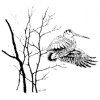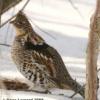Seasons End
-
Similar Content
-
By ltnic
We're happy to offer a hunting parcel of 72+ acres on our 169.35 acre farm for you to hunt our many whitetail deer, turkeys, grouse and small game. The farm is a paradise for deer with over 300 wild apple trees throughout the property, open meadows, hay fields, deep timber and water in multiple places. We're only a ~3 hour drive from NYC making us a great weekend hunting getaway in a beautiful & serene setting. This is the eastern half of our farm. We're located 8 miles from Norwich and 18 miles from Oneonta where you can seek lodging, restaurants and shopping. Our 4 bedroom, 4 bath house, nice post and beam barn and 169.35 acres are available for sportsman interested in purchasing property.
You can book your hunt on our property through our LandTrust profile here: https://www.landtrust.com/l/grassmere-farm-east/5d92408a-f38c-4f64-98c3-97251a8b626f
-
By mike rossi
Ruffed Grouse Society 451 McCormick Rd
Coraopolis PA 15108
(412) 262-4044
www.ruffedgrousesociety.org
February 13, 2014 For Immediate Release
Ruffed Grouse Society Expands Forest Habitat Effort with Creation of the American Woodcock Society Coraopolis, PA - The Ruffed Grouse Society (RGS) is proud to announce the creation of the American Woodcock Society (AWS), a branch of RGS initiated to expand forest habitat efforts and upland hunting opportunities to new landscapes across the nation. “The formation of the American Woodcock Society is a landmark event for forest conservation in the United States. The Ruffed Grouse Society has been the leader in woodcock conservation for decades. The creation of AWS expands existing efforts while advancing habitat creation and membership reach to additional regions that may not have ruffed grouse populations,” said RGS/AWS President and CEO John Eichinger. While grouse and woodcock share similar habitats, they don’t coexist across all landscapes, and AWS advances forest management and mission outreach to states that may not have grouse populations, especially in the southern United States where the majority of woodcock spend the winter months. Enhancing habitat in these regions also benefits many songbirds and other wildlife that rely upon young forest habitats. In addition, these regions continue to have a strong bird-hunting culture, and the habitat created by RGS/AWS will strengthen and expand these sporting traditions. “The goal of our organization is, and always has been, to preserve our sporting traditions by creating healthy forests for grouse, woodcock and other forest wildlife. At this crucial time in forest management from Alaska to the Gulf of Mexico, the AWS allows us to positively affect our nation’s forests and to spread awareness of our mission to a significantly larger group of supporters. The bottom line is that RGS and AWS will be able to collectively benefit more members, officials, conservationists and hunters who are passionate about the birds we love,” Eichinger concluded. The AWS will begin operations immediately, and anyone interested in AWS habitat efforts, chapters or membership can contact RGS/AWS at (412) 262-4044 or [email protected]. ***The Ruffed Grouse Society and American Woodcock Society are North America’s foremost conservation organizations dedicated to preserving our sporting traditions by creating healthy forest habitat for ruffed grouse, American woodcock and other wildlife. RGS and AWS work with landowners and government agencies to develop critical habitat utilizing scientific management practices.
Information on RGS/AWS, our mission, management projects and membership can be found on the web at: www.ruffedgrousesociety.org
.
-
By mudbat
New York State Department of Environmental Conservation (DEC) proposes to manage the Tug Hill Wildlife Management Area for mature, closed-canopy forest (NOT good grouse, hare or other game habitat) unless they receive significant opposition to their plan. DEC is accepting public comment on the draft Tug Hill North Unit Management Plan through this Friday, Dec. 20. The draft plan (http://www.dec.ny.gov/docs/regions_pdf/thndrump.pdf) outlines management direction for 8 State Forest parcels totalling about 37,000 ac, and the Tug Hill WMA (5,111 ac).
Most of the Tug Hill WMA (approx. 5,000 acres) was purchased using Pittman-Robertson Wildlife Restoration Funds, which are a federal excise tax on firearms, ammunition, and archery equipment which were championed by hunters for the purposes of “…restore, enhance, and manage wildlife resources, and to conduct state hunter education programs.” However, NYSDEC proposes only uneven-age forest management for the Tug Hill WMA, which will make the Tug Hill WMA less suitable for grouse, woodcock, hares, deer, and bear, rather than improve it for these species. The draft plan does mention creation of early successional habitat for at least a portion of the state forest parcels (although it's unclear how much, where or when).
Please tell DEC that the Tug Hill Wildlife Management Area should be actively managed using even-age forestry practices to make this WMA the premier destination for upland hunters seeking ruffed grouse, American woodcock, and snowshoe hare in the Tug Hill Plateau of upstate New York.
The DEC is accepting written comments on the draft Tug Hill North Unit Management Plan through this Friday, December 20, 2013, by mail to: Andrea Mercurio at DEC 7327 State Hwy 812, Lowville, New York 13367 or e-mail [email protected] . In your comments you may like to use the following bullets:
• Thank DEC for the opportunity to comment, and for the balanced multi-use proposal for the state forest parcels in the northern part of the Tug Hill North Unit.
• A major portion of the Tug Hill WMA should be managed using even-age forestry practices to improve habitat for ruffed grouse, American woodcock, snowshoe hare, and other wildlife, and make Tug Hill WMA the premier publicly-owned property in the region for sportsmen and sportswomen seeking these species.
Thank you! – Andrew Weik, Northeast Regional Biologist, Ruffed Grouse Society
-
By grouse28
Been thinking of returning to hunt Ft Drum for grouse and woodcock. Have not hunted there since late 70's early 80's.
Remember times of 30 to 40 grouse flushes per day. What is it like in recent years?
Just returned from Moosehead Lake,ME and had a great time in the northwoods chasing birds with my English and assorted GSP's.
Not looking for your special covert, just an idea of the bird numbers in Drum.
-
-
Recently Browsing 0 members
No registered users viewing this page.





Recommended Posts
Join the conversation
You can post now and register later. If you have an account, sign in now to post with your account.